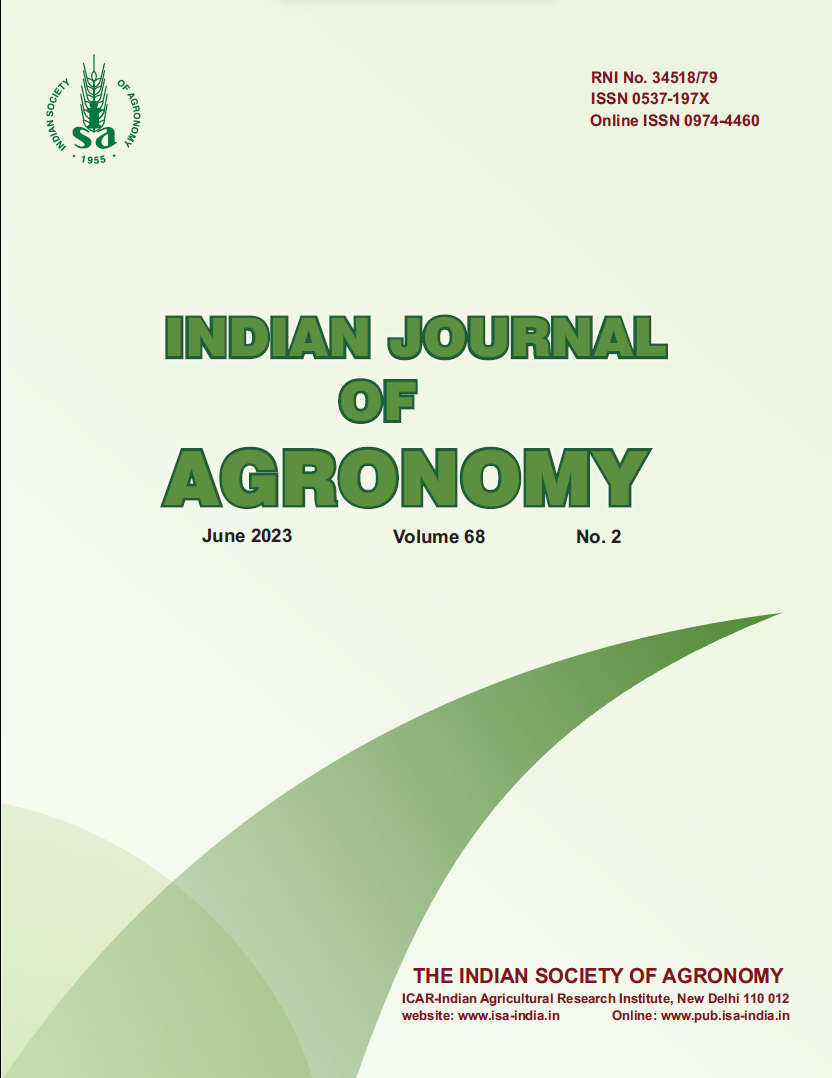Alternate tillage and crop-establishment techniques in rice (Oryza sativa)–wheat (Triticum aestivum) system for increased system productivity and profitability in eastern sub-Himalayan plains of India
DOI:
https://doi.org/10.59797/ija.v68i2.346Keywords:
Alternate tillage, Crop-establishment techniques, Energy relations, Productivity, Profitability, Rice–wheat systemAbstract
This study was undertaken from the rainy season 2015 to winter season 2016–17 at the Uttar Banga Krishi Viswavidyalaya, Pundibari, West Bengal. The aim of the study was to arrive at optimal tillage requirement in rice (Oryza sativa L.)–wheat (Triticum aestivum L.) system to economize on energy, labour and time, and to work out the production economics of rice–wheat system as a whole under various crop-establishment techniques. Unpuddled rice (UPTR) followed by zero tillage (ZT) wheat recorded superior yield performances to conventional tillage-based systems over the years. Fuel and labour requirement was reduced by 86.93 and 51.85%, 66.28 and 45.67% and 77.84 and 48.97% under rice (direct seeding)–wheat (surface seeding), rice (UPTR)–wheat (ZT) and rice (bed planting)–wheat (bed planting), respectively. Rice (UPTR)–wheat (ZT) also recorded the maximum energy efficiency (12.15) and energy productivity (0.94 kg/MJ) with lowest specific energy (31.67) which was reflective of the better system output. Despite lesser cost of cultivation under rice (direct seeding)–wheat (surface seeding) system, the monetary returns as well as benefit: cost ratio were much lesser under this system due to poor crop stand owing to high pre-monsoon and monsoon shower. The maximum net returns (`33,888 and `42,835/ha during 2015–16 and 2016–17 respectively) and benefit: cost ratio (1.68 and 1.85 during 2015–16 and 2016–17 respectively) under rice (UPTR)–wheat (ZT) system reflected its superiority to the other establishment techniques.
References
Aghaalikhani, M., Kazemi-Poshtmasari, H. and Habibzadeh, F. 2013. Energy use pattern in rice production: A case study from Mazandaran province, Iran. Energy Conversion and Management 69: 157–162.
Aravindakshan, S., Rossi, F. and Krupnik T.J. 2015. What does benchmarking of wheat farmers practicing conservation tillage in the eastern Indo-Gangetic Plains tell us about energy use efficiency? An application of slack-based data envelopment analysis. Energy 90: 483–493.
Humphreys, E., Kukal, S.S., Christen, E.W., Hira, G.S., Singh, B., Yadav, S. and Sharma, R. K. 2010. Halting the groundwater decline in north-west India–Which crop technologies will be winners? Advances in Agronomy 109: 155–217.
Islam, S., Gathala, M.K., Tiwari, T.P., Timsina, J., Liang, A.M., Maharajan, S., Chowdhury, A.K., Bhattacharya, P.M., Dhar, T., Mitra, B., Kumar, S., Srivastava, P.K., Dutta, S.K., Shrestha, R., Manandhar, S., Shrestha, S.R., Paneru, P., Siddique, N., Hossain, A., Islam, R., Ghosh, A.K., Rahman, M.A., Kumar, U., Rao, K.K and Gerard, B. 2019. Conservation agriculture-based sustainable intensification: Increasing yields and water productivity for smallholders of the Eastern Gangetic Plains. Field Crops Research 238: 1–17.
Jat, H.S., Datta, A., Choudhary, M., Yadav, A.K., Choudhary, V., Sharma, P.C., Gathala, M.K., Jat, M.L. and Mcdonald, A. 2021. Effect of tillage, crop establishment and diversification of soil organic carbon, aggregation, aggregate associated carbon and productivity in cereal systems of semi-arid Northwest India. Soil and Tillage Research 190: 128–138.
Jat, H.S., Datta, S., Sharma, P.C., Kumar, V., Yadav, Y.K., Choudhary, M., Choudhary, V., Gathala, M.K., Sharma, D.K., Jat, M.L., Yaduvanshi, N.P.S., Singh, G. and Mcdonald, A. 2017. Assessing soil properties and nutrient availability under conservation agriculture practices in a reclaimed sodic soil in cereal-based systems of North-West India. Archives of Agronomy and Soil Science https://doi.org/10.1080/03650340.2017.1359415
Kumar, V., Saharawat, Y.S., Gathala, M.K., Jat, A.S., Singh, S.K., Chaudhary, N. and Jat, M. L. 2013. Effect of different tillage and seeding methods on energy use efficiency and productivity of wheat in the Indo-Gangetic Plains. Field Crops Research 142: 1–8.
Li, P., Karunanidhi, D., Subramani, T. and Srinivasamoorthy, K. 2021. Sources and consequences of groundwater contamination. Archives of Environmental Contamination and Toxicology 80(1): 1–10.
Mitra, B., Patra, K., Bhattacharya, P.M. and Chowdhury, A.K. 2018. Unpuddled transplanting: A productive, profitable and energy-efficient establishment technique in rice under Eastern sub-Himalayan plains. Oryza 55(3): 459–466.
Mitra, B., Majumdar, K., Dutta, S.K., Mondal, T., Das, S., Banerjee, H., Ray, K. and Satyanarayana, T. 2019. Nutrient management in wheat (Triticum aestivum) production system under conventional and zero tillage in eastern sub-Himalayan plains of India. Indian Journal of Agricultural Sciences 89(5): 775–784.
Mitra, B. and Patra, K. 2019. Performance of rice–wheat cropping system under conservation agriculture-based establishment techniques in eastern Indian plains. Journal of Cereal Research 11(3): 278–274.
Mittal, J.P. and Dhawan, K.C. 1988. Research Manual on Energy Requirements in Agricultural Sector. Indian Council of Agricultural Research, New Delhi, pp. 20–23.
Mondal, T., Mitra, B. and Das, S. 2018. Precision nutrient management in wheat (Triticum aestivum L.) using Nutrient Expert: Growth phenology, yield, nitrogen- use efficiency and profitability under eastern sub-Himalayan plains. Indian Journal of Agronomy 63(2): 174–180.
Naresh, R. K., Gupta, R.K., Gangwar, L.K., Kumar, A., Singh, P.K. and Tomar, S.S. 2011. Wheat cultivars and nitrogen placement on yield and yield contributing characters of wheat in relation to resource conservation technologies. Plant Archives 11(2): 665–671.
Rahman, S. and Rahman, S. 2013. Energy productivity and efficiency of maize accounting for the choice of growing season and environmental factors: anempirical analysis from Bangladesh. Energy 49: 339–346.
Saharawat, Y. S., Singh, B., Malik, R.K., Ladha, J.K., Gathala, M. K., Jat, M.L. and Kumar, V. 2010. Evaluation of alternative tillage and crop-establishment methods in a rice–wheat rotation in Northwestern IGP. Field Crops Research 116: 260–267.
Sharma, A.R. 2021. Conservation agriculture in India: History, progress and way forward. Indian Journal of Agronomy 66(1): 1–18.
Sharma, P.K., Ladha, J.K. and Bhushan, L. 2003. Soil physical effects of puddling in rice–wheat cropping system. (In) Improving the productivity and sustainability of rice–wheat systems: Issues and impacts, Ladha, J.K. et al. (Eds). ASA Special Publication 65 ASA, CSSA and SSSA, Madison, WI. pp. 97–114.
Singh, M.K., Pal, S.K., Thakur, R. and Verma, V.N. 1997. Energy input–output relationship of cropping systems. Indian Journal of Agricultural Sciences 67: 262–264.
Timsina, J. and Connor, D.J. 2001. Productivity and management of rice–wheat cropping systems: Issues and challenges. Field Crops Research 69: 93–132.






